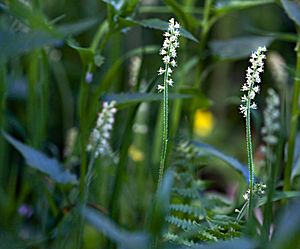Bensoniella facts for kids
Quick facts for kids Bensoniella |
|
|---|---|
 |
|
| Scientific classification | |
| Genus: |
Bensoniella
|
| Species: |
oregona
|
Bensoniella is a special group of plants in the saxifrage family. This group has only one type of plant, called Bensoniella oregona. You might also hear it called B. oregana, or by its common names, Oregon bensoniella or just bensoniella.
This plant is found only in a specific area: the Klamath Mountains in northern California and southern Oregon. This means it is endemic to that region. It likes to grow in wet forest areas and meadows that are high up, usually above 1,000 meters (about 3,300 feet) in elevation.
About Bensoniella oregona
Bensoniella is a perennial herb, which means it lives for more than two years and has soft stems, not woody ones. It grows from an underground stem called a rhizome. Its leaves are rounded or heart-shaped and have soft, woolly stems called petioles.
What It Looks Like
The plant produces tall, thin stalks of flowers called racemes. Each flower is white and has bright yellow-pink parts called anthers. After flowering, the plant makes many seeds inside small capsules.
How It Reproduces
Bensoniella oregona can make new plants in two ways. It can grow new plants from its seeds, which is called sexual reproduction. Interestingly, it often self-pollinates, meaning it uses its own pollen to make seeds. It can also make new plants without seeds, which is called vegetative reproduction. This happens when parts of the plant, like its rhizome, grow into new individual plants.
Why It Needs Care
Even though Bensoniella oregona is not currently considered an endangered species, it is a plant that scientists are watching closely. There are a few reasons for this concern:
- Limited Variety: Because it often self-pollinates and reproduces without seeds, it doesn't have much genetic diversity. This means all the plants are very similar, which can make them less able to adapt to changes in their environment.
- Specific Home: It can only live in certain types of wet habitats, which makes it harder for it to survive if those places change.
- Small Area: It grows in a relatively small area, so if something happens there, it could affect many plants.
- Habitat Changes: Its home is sometimes affected by human activities like logging (cutting down trees), grazing (animals eating plants), and building roads. These activities can change its habitat and lead to Erosion, where soil is washed away.
The first time this plant was collected by scientists was in 1916 by a person named John Hunter Thompson.
See also
 In Spanish: Bensoniella de Oregon para niños
In Spanish: Bensoniella de Oregon para niños

